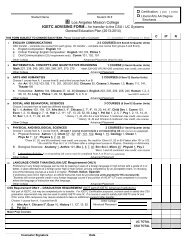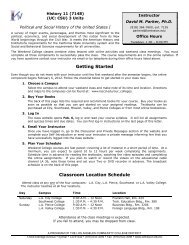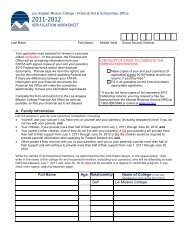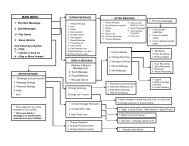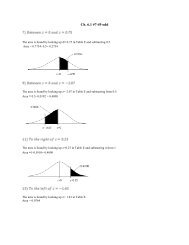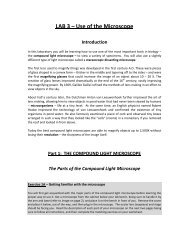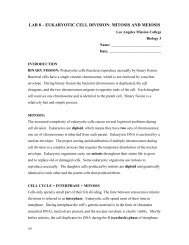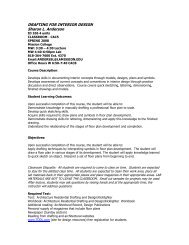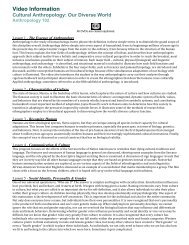You also want an ePaper? Increase the reach of your titles
YUMPU automatically turns print PDFs into web optimized ePapers that Google loves.
*Exercise 1 – Digestion of cream by lipase<br />
In this exercise you will test the ability of pancreatic lipase to digest triglycerides in cream, both<br />
with and without bile. The cream contains litmus, a pH indicator that turns red under acidic<br />
conditions, blue under basic conditions, and is purple at neutral pH. The “litmus cream” you will<br />
use is a neutral lavender color and will gradually turn reddish-pink if free fatty acids are released<br />
due to the digestion of triglycerides. Your reactions should be performed as follows:<br />
1. label four test tubes 1, 2, 3 & 4 and add 2 ml of litmus cream to each tube<br />
2. add a pinch (~0.02 g or 20 mg) of bile powder to tubes 2 & 4 only<br />
3. add 0.5 ml of water to tubes 1 & 2 and 0.5 ml of 1% lipase solution to tubes 3 & 4<br />
4. mix each tube well and incubate them in a 37 o C water bath for 1 hour<br />
5. record the results on your worksheet and answer the associated questions<br />
NOTE: For exercises 1 & 2, begin the next exercise while the current one is incubating.<br />
Digestion of Proteins by the Enzyme Trypsin<br />
The next enzyme you will examine is trypsin, one of many enzymes your body produces to<br />
digest or break down proteins. Trypsin will catalyze the breakage of peptide bonds in proteins at<br />
lysine and arginine amino acid residues. This results in larger polypeptides being broken down<br />
into smaller polypeptides (commonly referred to as “peptides”).<br />
The protein source you will subject to trypsin digestion is gelatin. Gelatin consists primarily of<br />
the protein collagen extracted from animal bones and other connective tissues. At room<br />
temperature and below, gelatin is a semisolid gel due to interactions between the collagen fibers<br />
that form a fishnet-like structure. Trypsin will partially digest the collagen fibers, disrupting<br />
their interaction and causing the gelatin to liquefy and remain liquid, even at cool temperatures.<br />
*Exercise 2 – Digestion of gelatin by trypsin<br />
To demonstrate the ability of trypsin to catalyze the partial digestion of gelatin, you will carry<br />
out two reactions as described below. If digestion of the gelatin has occurred, you will see that<br />
the gelatin remains liquid even on ice:<br />
1. obtain two tubes of molten gelatin from the 37 o C water bath and label them 1 & 2<br />
2. add 0.5 ml of water to tube 1 and 0.5 ml of 1% trypsin solution to tube 2<br />
3. mix well and place both tubes in the 37 o C water bath for 30 minutes<br />
4. place both tubes on ice for 15 minutes (or long enough for tube 1 to solidify)<br />
5. invert each tube to see if the gelatin is liquid or solid and record on your worksheet<br />
5



